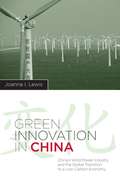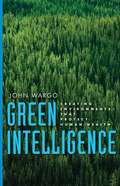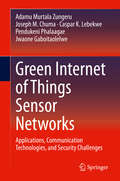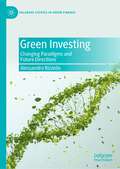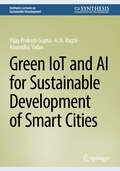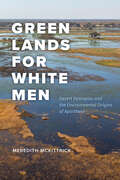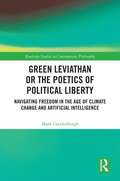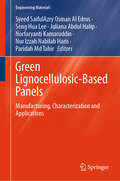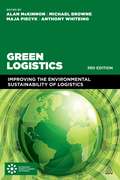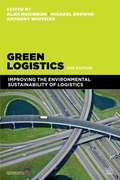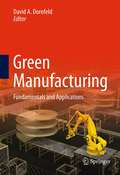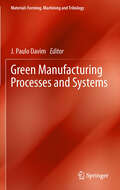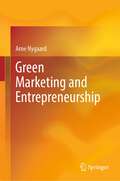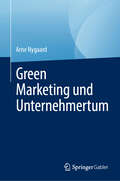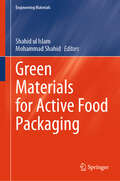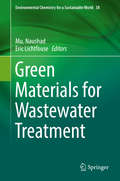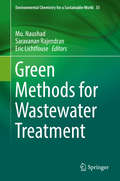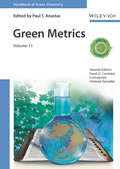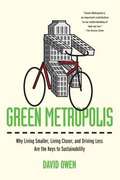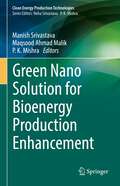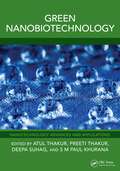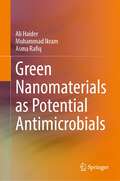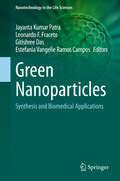- Table View
- List View
Green Innovation in China
by Joanna I LewisAs the greatest coal producing and consuming nation in the world, China would seem an unlikely haven for wind power. Yet the country now boasts a world-class industry that promises to make low-carbon technology more affordable and available to all. Conducting an empirical study of China's remarkable transition and the possibility of replicating their model elsewhere, Joanna I. Lewis adds greater depth to a theoretical understanding of China's technological innovation systems and the country's current and future role in a globalized economy.Lewis focuses on China's specific methods of international technology transfer, its forms of international cooperation and competition, and its implementation of effective policies that promoted the development of a home-grown industry. Just a decade ago, China claimed only a handful of operating wind turbines-all imported from Europe and the United States. Today, the country is the largest wind power market in the world, with turbines made almost exclusively in its own factories. Studying this shift reveals how China's political leaders have responded to domestic energy challenges and how they may confront climate change. The nation's ability to escalate its use of wind power also demonstrates China's ability to leapfrog to cleaner energy technologies-a path equally viable for other developing countries hoping to bypass gradual industrialization and the "technological lock-in" of hydrocarbon-intensive energy infrastructure. Though setbacks are possible, China could come to dominate global wind turbine sales, becoming a hub of technological innovation and a major instigator of low-carbon economic change.
Green Innovation in China: China's Wind Power Industry and the Global Transition to a Low-Carbon Economy (Contemporary Asia in the World)
by Joanna LewisAs the greatest coal-producing and consuming nation in the world, China would seem an unlikely haven for wind power. Yet the country now boasts a world-class industry that promises to make low-carbon technology more affordable and available to all. Conducting an empirical study of China's remarkable transition and the possibility of replicating their model elsewhere, Joanna I. Lewis adds greater depth to a theoretical understanding of China's technological innovation systems and its current and future role in a globalized economy. Lewis focuses on China's specific methods of international technology transfer, its forms of international cooperation and competition, and its implementation of effective policies promoting the development of a home-grown industry. Just a decade ago, China maintained only a handful of operating wind turbines—all imported from Europe and the United States. Today, the country is the largest wind power market in the world, with turbines made almost exclusively in its own factories. Following this shift reveals how China's political leaders have responded to domestic energy challenges and how they may confront encroaching climate change. The nation's escalation of its wind power use also demonstrates China's ability to leapfrog to cleaner energy technologies—an option equally viable for other developing countries hoping to bypass gradual industrialization and the "technological lock-in" of hydrocarbon-intensive energy infrastructure. Though setbacks are possible, China could one day come to dominate global wind turbine sales, becoming a hub of technological innovation and a major instigator of low-carbon economic change.
Green Intelligence: Creating Environments That Protect Human Health
by John WargoWe live in a world awash in manmade chemicals, from the pesticides on our front lawns to the diesel exhaust in the air we breathe. Although experts are beginning to understand the potential dangers of these substances, there are still more than 80,000 synthetic compounds that have not been sufficiently tested to interpret their effects on human health. Yale University professor John Wargo has spent much of his career researching the impact of chemical exposures on women and children. In this book, he explains the origins of society's profound misunderstanding of everyday chemical hazards and offers a practical path toward developing greater "green intelligence. " Despite the rising trend in environmental awareness, information about synthetic substances is often unavailable, distorted, kept secret, or presented in a way that prevents citizens from acting to reduce threats to their health and the environment. By examining the histories of five hazardous technologies and practices, Wargo finds remarkable patterns in the delayed discovery of dangers and explains the governments' failures to manage them effectively. Sobering yet eminently readable, Wargo's book ultimately offers a clear vision for a safer future through prevention, transparency, and awareness.
Green Internet of Things Sensor Networks: Applications, Communication Technologies, and Security Challenges
by Adamu Murtala Zungeru Joseph M. Chuma Caspar K. Lebekwe Pendukeni Phalaagae Jwaone GaboitaolelweThis book presents methods for advancing green IoT sensor networks and IoT devices. Three main methods presented are: a standalone system to support IoT devices that is informed by the amount of energy the solar array system can produce; a model of securing a building's main power supply against unauthorized use; and security of the IoT devices and their networks. For each, the authors outline the methods, presents security and privacy issues, and their solutions. The work suggests a layered approach to expose security issues and challenges at each layer of the IoT architecture and proposes techniques used to mitigate these challenges. Finally, perspectives are drawn and discussed for future directions in securing IoT sensor networks, covering evolving areas such as artificial intelligence, blockchain technology, sensor Internet of People, context-aware sensing, cloud infrastructure, security and privacy, and the Internet of Everything.
Green Investing: Changing Paradigms and Future Directions (Palgrave Studies in Impact Finance)
by Alessandro RizzelloThis book provides a unique picture of green finance by highlighting, under both theoretical and practical lenses, current changing paradigms and future directions in this field. The book is founded upon four major aspects that characterize current debates in green finance: products and services, financial innovation, green washing and transparency, and external pressures. The book is particularly useful to understand the current perimeter of the field; identify the potentials and challenges of the sector; explore current changing paradigms and its potentials to act as drivers for mainstreaming green finance; and conceptualize future directions of the field, with particular focus on its role in the post-COVID recovery plans. The book therefore is not only useful for deriving theoretical or practical implications for researchers and policy makers, but also to capture the evolving complexity of the field at the eve of extraordinary and green-driven changes in financial industry and in policy programs. The book also opens up interesting questions on theoretical advances in financial theory derived from these innovations and accelerated by the pandemic. It will be of interest to scholars and students from different academic disciplines such as economics, finance, political science, and entrepreneurship, as well as practitioners interested in green finance and in the financing of environmentally impactful organizations and projects.
Green IoT and AI for Sustainable Development of Smart Cities (Synthesis Lectures on Sustainable Development)
by A. K. Haghi Vijay Prakash Gupta Anuradha YadavA Smart City is an urban area in which digital technology is used to connect the infrastructure and services to improve the efficiency of the city&’s operations and the quality of life of its population in terms of mobility, energy, security, housing, and more. This book describes the systems and the infrastructure requirements of smart cities and explores how the integration of the Green Internet of Things (G-IoT) and Artificial Intelligence (AI) help improve the efficiency and safety of cities&’ systems, as well as reduce costs. The book provides useful information for researchers, policymakers, urban planners, and technology leaders.
Green Lands for White Men: Desert Dystopias and the Environmental Origins of Apartheid (science.culture)
by Meredith McKittrickHow an audacious environmental engineering plan fanned white settlers’ visions for South Africa, stoked mistrust in scientific experts, and gave rise to the Apartheid state. In 1918, South Africa’s climate seemed to be drying up. White farmers claimed that rainfall was dwindling, while nineteenth-century missionaries and explorers had found riverbeds, seashells, and other evidence of a verdant past deep in the Kalahari Desert. Government experts insisted, however, that the rains weren’t disappearing; the land, long susceptible to periodic drought, had been further degraded by settler farmers’ agricultural practices—an explanation that white South Africans rejected. So when the geologist Ernest Schwarz blamed the land itself, the farmers listened. Schwarz held that erosion and topography had created arid conditions, that rainfall was declining, and that agriculture was not to blame. As a solution, he proposed diverting two rivers to the Kalahari’s basins, creating a lush country where white South Africans could thrive. This plan, which became known as the Kalahari Thirstland Redemption Scheme, was rejected by most scientists. But it found support among white South Africans who worried that struggling farmers undermined an image of racial superiority. Green Lands for White Men explores how white agriculturalists in southern Africa grappled with a parched and changing terrain as they sought to consolidate control over a Black population. Meredith McKittrick’s timely history of the Redemption Scheme reveals the environment to have been central to South African understandings of race. While Schwarz’s plan was never implemented, it enjoyed sufficient support to prompt government research into its feasibility, and years of debate. McKittrick shows how white farmers rallied around a plan that represented their interests over those of the South African state and delves into the reasons behind this schism between expert opinion and public perception. This backlash against the predominant scientific view, McKittrick argues, displayed the depth of popular mistrust in an expanding scientific elite. A detailed look at the intersection of a settler society, climate change, white nationalism, and expert credibility, Green Lands for White Men examines the reverberations of a scheme that ultimately failed but influenced ideas about race and the environment in South Africa for decades to come.
Green Leviathan or the Poetics of Political Liberty: Navigating Freedom in the Age of Climate Change and Artificial Intelligence (Routledge Studies in Contemporary Philosophy)
by Mark CoeckelberghThis book discusses the problem of freedom and the limits of liberalism considering the challenges of governing climate change and artificial intelligence (AI). It mobilizes resources from political philosophy to make an original argument about the future of technology and the environment. Can artificial intelligence save the planet? And does that mean we will have to give up our political freedom? Stretching the meaning of freedom but steering away from authoritarian options, this book proposes that, next to using other principles such as justice and equality and taking collective action and cooperating at a global level, we adopt a positive and relational conception of freedom that creates better conditions for human and non-human flourishing. In contrast to easy libertarianism and arrogant techno-solutionism, this offers a less symptomatic treatment of the global crises we face and gives technologies such as AI a role in the gathering of a new, more inclusive political collective and the ongoing participative making of new common worlds. Written in a clear and accessible style, Green Leviathan or the Poetics of Political Liberty will appeal to researchers and students working in political philosophy, environmental philosophy, and the philosophy of technology.
Green Lignocellulosic-Based Panels: Manufacturing, Characterization and Applications (Engineering Materials)
by Norfaryanti Kamaruddin Paridah Md Tahir Seng Hua Lee Syeed SaifulAzry Osman Al Edrus Juliana Abdul Halip Nur Izzah Nabilah HarisThis book highlights the properties of lignocellulosic-based panels bonded with green binders. The material(s) to produce these panels can be wood or non-wood based and bonded with any kind of green-based binders namely lignin-, starch-, plant protein-, tannin/bark-, and oil vegetable. The classification of panels is not limited to veneer-based, laminated-based, composite-based (i.e. fibreboard, particleboard), and others such as wood or non-wood fibre-polymer composites. Processing and manufacturing of green binder composites made from lignocellulosic materials is discussed in this book. In addition, the mechanical and physical properties of green binder composites are also discussed. The book is useful for researchers, professionals and policy makers.
Green Logistics (Third Edition)
by Anthony Whiteing Alan Mckinnon Michael Browne Maja PiecykAs concern for the environment rises, companies must take more account of the external costs of logistics associated mainly with climate change, air pollution, noise, vibration and accidents. Leading the way in current thinking on environmental logistics, Green Logistics provides a unique insight on the environmental aspects of logistics. Edited by a leading team of academics with contributions from global industry leaders and researchers, it examines key issues facing the logistics industry today. Fully updated and revised, the 3rd Edition takes a more global perspective. It introduces new contributors and insightful international case studies that illustrate the impact of green logistics in practice. There is a new chapter on green hinterland logistics considering port and maritime issues written by Jean-Paul Rodrigue and Adolf Ng and four postscripts written by the editors on hot topics in the field. Ideal for use on related courses, the 3rd Edition includes indispensable online supporting materials as well as technical information and guidelines for teachers and lecturers. The book is endorsed by the Chartered Institute of Logistics and Transport (CILT).
Green Logistics: Improving the Environmental Sustainability of Logistics
by Anthony Whiteing Alan Mckinnon Michael BrowneAs concern for the environment rises, companies must take more account of the external costs of logistics associated mainly with climate change, air pollution, noise, vibration and accidents. Green Logistics analyses the environmental consequences of logistics and how to deal with them. Written by a leading team of logistics academics, the book examines ways of reducing these externalities and achieving a more sustainable balance between economic, environmental and social objectives. It examines key areas in this important subject including: carbon auditing of supply chains; transferring freight to greener transport modes; reducing the environmental impact of warehousing; improving fuel efficiency in freight transport; reverse logistics for the management of waste. The new edition is completely updated throughout with new methodologies and case studies to illustrate the impact of green logistics in practice.
Green Manufacturing
by David A. DornfeldGreen Manufacturing: Fundamentals and Applications introduces the basic definitions and issues surrounding green manufacturing at the process,machine and system (including supply chain) levels. It also shows, by way of several examples from different industry sectors, the potential for substantial improvement and the paths to achieve the improvement. Additionally, this book discusses regulatory and government motivations for green manufacturing and outlines the path for making manufacturing more green as well as making production more sustainable.
Green Manufacturing Processes and Systems
by Paulo Davim JThis book provides the recent advances on green manufacturing processes and systems for modern industry. Chapter 1 provides information on sustainable manufacturing through environmentally-friendly machining. Chapter 2 is dedicated to environmentally-friendly machining: vegetable based cutting fluids. Chapter 3 describes environmental-friendly joining of tubes. Chapter 4 contains information on concepts, methods and strategies for zero-waste in manufacturing. Finally, chapter 5 is dedicated to the application of hybrid MCDM approach for selecting the best tyre recycling process. This book serves as a research book for students at final undergraduate engineering course or at postgraduate level. It is a reference for professionals in industries related to manufacturing and new green jobs (green products, renewable energy, green services and environmental conservation).
Green Marketing and Entrepreneurship
by Arne NygaardThis comprehensive book reveals the intricate interplay between entrepreneurship, strategy, and marketing management in the context of sustainability. The book champions the green shift within businesses and organizations, equipping both companies and consumers with the knowledge needed to make well-informed decisions that drive positive market transformations. Providing a holistic understanding of sustainable and disruptive change processes for students and professionals, it looks into a spectrum of powerful strategies, ranging from green marketing approaches and segmentation techniques to the nuances of demarketing and green branding. Readers will uncover the critical role of companies and decision-makers in reshaping consumer behavior and supply chains, while navigating potential pitfalls like the "tragedy of the commons" and "greenwashing." Furthermore, they will gain valuable insights into how strategic positioning and targeted efforts can yield sustainable outcomes and increase consumer willingness to invest in environmentally conscious products. Green Marketing and Entrepreneurship allows readers to explore the profound impact of marketing strategies on the delicate balance of nature and discover actionable green marketing methodologies that can pave the way for a more sustainable and environmentally conscious world.
Green Marketing und Unternehmertum
by Arne NygaardDieses umfassende Buch offenbart das komplexe Zusammenspiel von Unternehmertum, Strategie und Marketingmanagement im Kontext der Nachhaltigkeit. Das Buch befürwortet den grünen Wandel innerhalb von Unternehmen und Organisationen und stattet sowohl Unternehmen als auch Verbraucher mit dem Wissen aus, das erforderlich ist, um fundierte Entscheidungen zu treffen, die positive Markttransformationen vorantreiben. Es bietet ein ganzheitliches Verständnis für nachhaltige und disruptive Veränderungsprozesse für Studierende und Fachleute und untersucht ein Spektrum kraftvoller Strategien, die von grünen Marketingansätzen und Segmentierungstechniken bis hin zu den Feinheiten des Demarketings und des grünen Brandings reichen. Die Leser werden die entscheidende Rolle von Unternehmen und Entscheidungsträgern bei der Umgestaltung des Verbraucherverhaltens und der Lieferketten erkennen, während sie potenzielle Fallstricke wie die "Tragödie der Allmende" und "Greenwashing" navigieren. Darüber hinaus gewinnen sie wertvolle Einblicke, wie strategische Positionierung und gezielte Anstrengungen nachhaltige Ergebnisse erzielen und die Bereitschaft der Verbraucher erhöhen können, in umweltbewusste Produkte zu investieren. Green Marketing und Unternehmertum ermöglicht es den Lesern, die tiefgreifenden Auswirkungen von Marketingstrategien auf das empfindliche Gleichgewicht der Natur zu erkunden und umsetzbare grüne Marketingmethoden zu entdecken, die den Weg zu einer nachhaltigeren und umweltbewussteren Welt ebnen können.
Green Materials for Active Food Packaging (Engineering Materials)
by Mohammad Shahid Shahid Ul IslamThis book highlights the critical role of green materials in sustainable, active food packaging. Beginning with an introductory chapter outlining the importance of green materials and sustainability in food packaging, the book progresses through various topics, including the properties and applications of biopolymers, the potential of biodegradable materials, and antimicrobial agents to enhance food safety. Innovations like edible packaging, polymer nanocomposites, and smart sensors for monitoring quality are thoroughly examined, showcasing their roles in improving food preservation and safety. Additionally, the book evaluates the environmental benefits of natural, bio-based materials and their effectiveness in active packaging applications. Each chapter critically discusses the challenges, advancements, and regulatory considerations in adopting these innovative solutions. By providing a detailed analysis of the potential and challenges associated with green materials, this volume is a comprehensive guide for researchers, practitioners, and policymakers alike. It encourages continued research and development in sustainable food packaging, fostering a deeper understanding of how these materials can enhance environmental and food safety outcomes. It is a crucial addition to the literature on sustainable practices in the food industry.
Green Materials for Wastewater Treatment (Environmental Chemistry for a Sustainable World #38)
by Eric Lichtfouse Mu. NaushadThis book reviews health hazards associated with wastewater use and water pollutants. Chapters present applications of green materials made of agricultural waste, activated carbon and magnetic materials for wastewater treatment. The removal of toxic metals using algal biomass and the removal of toxic dyes using chitosan composite materials are also discussed. The book includes reviews on the removal of phenols, pesticides, and on the use of ionic liquid-modified activated carbon for the treatment of textile wastewater.
Green Methods for Wastewater Treatment (Environmental Chemistry for a Sustainable World #35)
by Eric Lichtfouse Mu. Naushad Saravanan RajendranThis book presents comprehensive chapters on the latest research and applications in wastewater treatment using green technologies. Topics include mesoporous materials, TiO2 nanocomposites and magnetic nanoparticles, the role of catalysts, treatment methods such as photo-Fenton, photocatalysis, electrochemistry and adsorption, and anti-bacterial solutions. This book will be useful for chemical engineers, environmental scientists, analytical chemists, materials scientists and researchers.
Green Metrics
by Paul T. Anastas David J. Constable Concepcion Jimenez GonzalesThere has been dramatic growth in the community of researchers and industrialists working in the area of Green Chemistry. There has been an increasing recognition by a wide-range of scientists and engineers in the chemical enterprise that the framework of Green Chemistry is relevant and enabling to their work. There has been a significant body of work that has accumulated over the past decade that details the breakthroughs, innovation and creativity within Green Chemistry and Engineering. While there have been edited volumes on Green Chemistry that collect a limited number of papers often on a particular topic area, there is not currently a series that seeks to provide a more comprehensive overview of the current state of the science. The lack of this type of series is a notable niche for which the continually growing Green Chemistry and engineering community would value and welcome.
Green Metropolis: Why Living Smaller, Living Closer, and Driving Less Are the Keys to Sustainability
by David OwenIn this remarkable challenge to conventional thinking about the environment, David Owen argues that the greenest community in the United States is not Portland, Oregon, or Snowmass, Colorado, but New York, New York. Most Americans think of crowded cities as ecological nightmares, as wastelands of concrete and garbage and diesel fumes and traffic jams. Yet residents of compact urban centers, Owen shows, individually consume less oil, electricity, and water than other Americans. They live in smaller spaces, discard less trash, and, most important of all, spend far less time in automobiles. Residents of Manhattan- the most densely populated place in North America -rank first in public-transit use and last in percapita greenhouse-gas production, and they consume gasoline at a rate that the country as a whole hasn't matched since the mid-1920s, when the most widely owned car in the United States was the Ford Model T. They are also among the only people in the United States for whom walking is still an important means of daily transportation. These achievements are not accidents. Spreading people thinly across the countryside may make them feel green, but it doesn't reduce the damage they do to the environment. In fact, it increases the damage, while also making the problems they cause harder to see and to address. Owen contends that the environmental problem we face, at the current stage of our assault on the world's nonrenewable resources, is not how to make teeming cities more like the pristine countryside. The problem is how to make other settled places more like Manhattan, whose residents presently come closer than any other Americans to meeting environmental goals that all of us, eventually, will have to come to terms with.
Green Nano Solution for Bioenergy Production Enhancement (Clean Energy Production Technologies)
by P. K. Mishra Manish Srivastava Maqsood Ahmad MalikThis edited book presents nanotechnology-based approaches to improve quality of biofuels production. It covers the use of different nanomaterials in various biofuels production methods and their sustainable utility analysis to improve production of biofuels at economical and mass scale. Environmentally friendly, low cost, and synthesis via green and renewable resources are the main key features covered by this book. Advantages and sustainability scope of green and renewable material to synthesize nanomaterial and reduction in synthesis cost over to chemical synthesis cost have been discussed in this book. The book also explores various green synthesis possibilities to synthesize nanomaterials that are frequently involved in biofuels production process as catalysts. Various feasible mechanisms have also been explained. Maximum and sustainable use of green nanomaterials at every step of biofuels production is also one of the major focuses of this book. It covers mega audiences, which include academician, researchers, and industries people. This book will be highly interesting for researchers and scientists as well as related industries.
Green Nanobiotechnology (Nanotechnology Advances and Applications)
by Atul Thakur Preeti Thakur Deepa Suhag Khurana, S. M. PaulThis book provides a comprehensive exploration of green nanotechnology covering principles, applications, and ethical considerations.Green Nanobiotechnology begins with an introductory exploration of nanotechnology, followed by in-depth discussions on the synthesis of ozone-friendly nanomaterials and the emerging practice of green synthesis. It delves into the diverse applications of green nanoparticles, spanning biomedical applications, tissue engineering, biosensors, antimicrobials, and vaccine development. It explores applications of nanotechnology in environmental sciences including bioremediation, microengineered ceramics for environmental protection, and the modification of advanced nano-polymer composites. The environmental fate and ecotoxicological implications of nanomaterials are thoroughly examined, followed by discussions on the energy-saving potential and sustainable fuel development in the realm of green nanotechnology. The book concludes with a focus on responsible and ethical considerations, addressing the legal, socio-economic, and ethical impacts of nanotechnology, making it an important resource for researchers, academics, and professionals in nanobiotechnology and biomedical sciences.
Green Nanomaterials as Potential Antimicrobials
by Muhammad Ikram Ali Haider Asma RafiqThis book focuses on nanomaterials with antibacterial properties. Antibacterial resistance is a growing concern that poses a serious threat to public health worldwide. This book looks at the fabrication, material's properties, and characterization of a range of metallic, bimetallic, and metal-oxide-based nanomaterials that can be exploited for their antimicrobial properties. A key focus of this book is its emphasis on ‘green’ synthesis of nanomaterials, as many conventional routes of nanomaterial fabrication do not fulfill key sustainability criteria in terms of their toxicity and lack of eco-friendliness. Additionally, this book introduces the application of nanoparticles to veterinary medicine. Given the ever-increasing global livestock population coupled with the emergence of drug-resistant pathogens of animal origin (bacterial, parasitic, and hemoprotozoa), the use of nanoparticles as antibacterial agents represents a paradigm shift in every aspect of veterinary care. Authored by scholars with combined expertise in nanomaterials and veterinary medicine, this book provides valuable information for researchers working on sustainable nanomaterials with antibacterial properties.
Green Nanomaterials: Processing, Properties, and Applications (Advanced Structured Materials #126)
by Shakeel Ahmed Wazed AliThis book comprises a collection of chapters on advances in green nanomaterials. The book looks at ways to establish long‐term safe and sustainable forms of nanotechnology through implementation of nanoparticle biosynthesis with minimum impact on the ecosystem. The book looks at synthesis, processing, and applications of metal and metal oxide nanomaterials and also at bio-nanomaterials. The contents of this book will prove useful for researchers and professionals working in the field of nanomaterials and green technology.
Green Nanoparticles: Synthesis and Biomedical Applications (Nanotechnology in the Life Sciences)
by Jayanta Kumar Patra Gitishree Das Leonardo F. Fraceto Estefania Vangelie Ramos CamposNanotechnology is the application of science to control matter at the molecular level. It has become one of the most promising applied technologies in all areas of science. Nanoparticles have multi-functional properties and have created very interesting applications in various fields such as medicine, nutrition, bioenergy, agriculture and the environment. But the biogenic syntheses of monodispersed nanoparticles with specific sizes and shapes have been a challenge in biomaterial science. Nanoparticles are of great interest due to their extremely small size and large surface-to-volume ratio, which lead to both chemical and physical differences in their properties (e.g., mechanical properties, biological and sterical properties, catalytic activity, thermal and electrical conductivity, optical absorption and melting point) compared to bulk of the same chemical composition. Recently, however, synthesizing metal nanoparticles using green technology via microorganisms, plants, viruses, and so on, has been extensively studied and has become recognized as a green and efficient way for further exploiting biological systems as convenient nanofactories. Thus the biological synthesis of nanoparticles is increasingly regarded as a rapid, ecofriendly, and easily scaled-up technology. Today researchers are developing new techniques and materials using nanotechnology that may be suitable for plants to boost their native functions. Recently, biological nanoparticles were found to be more pharmacologically active than physico-chemically synthesized nanoparticles. Various applications of biosynthesized nanoparticles have been discovered, especially in the field of biomedical research, such as applications to specific delivery of drugs, use for tumor detection, angiogenesis, genetic disease and genetic disorder diagnosis, photoimaging, and photothermal therapy. Further, iron oxide nanoparticles have been applied to cancer therapy, hyperthermia, drug delivery, tissue repair, cell labeling, targeting and immunoassays, detoxification of biological fluids, magnetic resonance imaging, and magnetically responsive drug delivery therapy. Nanoparticle synthesis for plant byproducts for biomedical applications has vast potential. This book offers researchers in plant science and biomedicine the latest research and opportunity to develop new tools for the synthesis of environmentally friendly and cost-effective nanoparticles for applications in biomedicine as well as other various fields.
